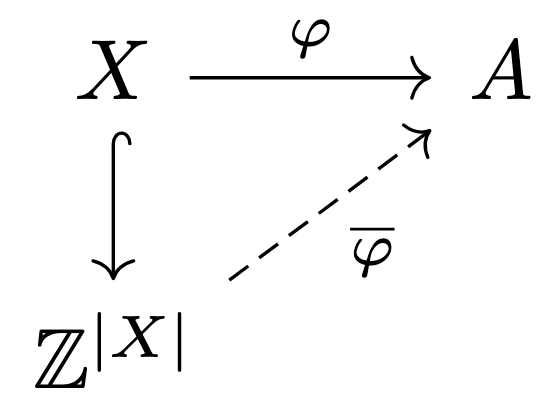Free abelian groups
The commutator subgroup of a group , denoted by , is defined to be .
Theorem 1(Lemma).
For any group , is a normal subgroup.
Proof
A subgroup is normal if for all , . Since is a product of commutators :
- Conjugate : , a commutator with , .
- For , , a product of commutators, so .
- Inverses follow similarly, as is a commutator.
Hence, .
Theorem 2(Lemma).
If is a free group, then is abelian.
Proof
Let and be any two elements in . Since , we have .
Note that since the quotient of a finitely generated group is finitely generated (the images of the generators generate the image), if is a finitely generated free group, is also finitely generated.
We will return to in a bit.
Definition 3.
A basis for an abelian group is a subset with the following properties:
- , that is, every may be written as where for only finitely many .
- is independent, that is, for any collection of integers such that only finitely many are nonzero we have
We will restrict our development to abelian groups with finite bases, so just work with and being independent without the additional clauses.
Theorem 4.
Let be an abelian group with finite basis . Then every element can be written uniquely as , . The map given by is an isomorphism, and .
Proof
It is easy to check that is a homomorphism.is onto by property 1 of a basis, and has trivial kernel by property 2. Thus, is an isomorphism, and unique linear decompositions of elements of in terms of follow.
Definition 5.
The group is called the free abelian group on . It has a canonical basis which is in bijective correspondence with .
Theorem 6.
If are nonnegative integers with , then .
It follows that if is a free abelian group and and are two bases for , then .
Definition 7.
The free abelian group of rank is defined to be the free abelian group on the set , which is isomorphic to .
The next theorem links free abelian groups with free groups.
Theorem 8.
If is the free group of rank , then is the free abelian group of rank .
Universal property of free abelian groups
Theorem 9.
Let be the free abelian group on . Let be the function defined by . If is an abelian group and is any map, then there exists a unique homomorphism that makes the following diagram commute:
This yields the following important corollary:
Theorem 10(Corollary).
Every abelian group is a quotient of a free abelian group.
Of interest to us is the finite case: if is a finitely generated abelian group generated by generators, then for some (remember, all subgroups of an abelian group are normal).
It follows that to classify all the finitely generated abelian groups, we need only classify the subgroups of and their corresponding quotient groups.
Theorem 11(Invariant factor theorem).
If is a subgroup of a free abelian group or rank , then is free abelian of rank . Further, there are bases of and of respectively where divides for . The integers are uniquely determined up to sign and are called the invariant factors of .
Theorem 12(Corollary: Structure theorem for finitely generated abelian groups).
A finitely generated abelian group is isomorphic to for some and dividing . The integer as well as all the s (up to sign) are uniquely determined.
I’m having trouble understanding the invariant factor theorem. Consider the standard basis for the free abelian group . Let be the subgroup of generated by . Is it correct that the invariant factor theorem says that there exists another basis of such that is a basis of and divides ? If so, can you find me the basis?
Consider the standard basis for the free abelian group . Let be the subgroup of generated by such that divides . The invariant factor theorem says that the s are uniquely determined up to sign.
Show that there does not exist a basis of such that the smallest positive integer that occurs as a coefficient in the expression of the elements of in terms of this basis is less than .
